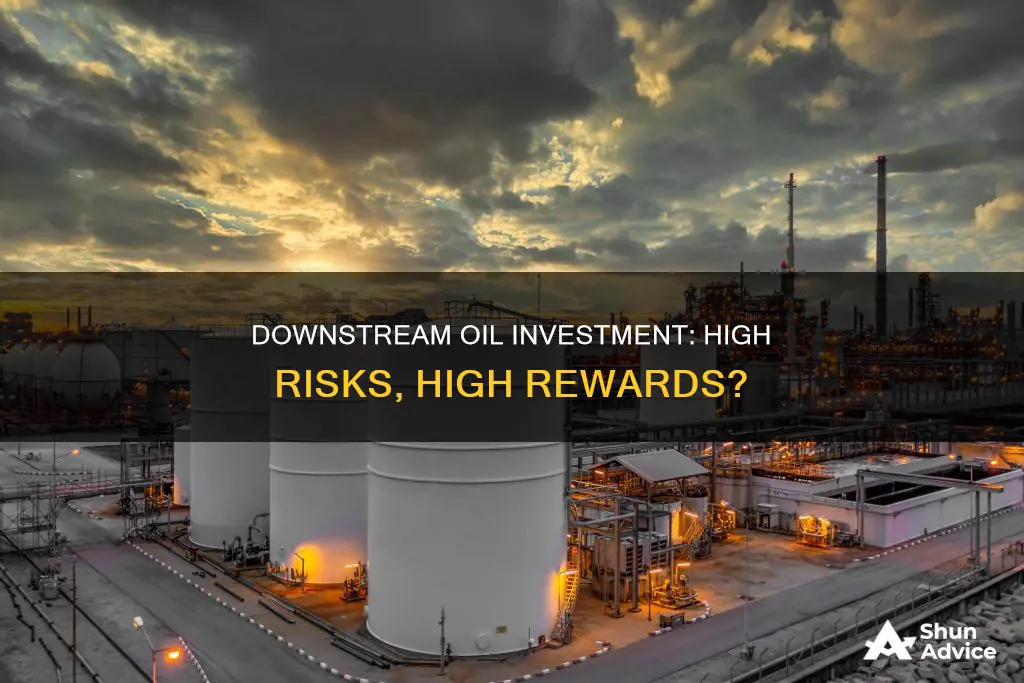
Investing in the downstream oil and gas industry comes with a unique set of risks that investors must carefully consider. Downstream activities revolve around turning crude oil and natural gas into finished products for consumers. Companies involved in this process include oil refineries, petrochemical plants, petroleum product distributors, natural gas distributors, and even retail outlets.
One benefit of investing in downstream companies is that they can benefit from an oversupply of crude oil and natural gas, as this leads to a fall in crude oil prices, increasing margins for refining activities. However, a potential downside is the seasonal slowdown of sales, as gasoline demand experiences seasonality. This can result in periods of low-profit margins or even operating at a loss for downstream companies.
Other risks associated with investing in the oil and gas industry as a whole, including downstream, are commodity price volatility, geopolitical tensions, environmental and regulatory changes, operational risks, capital intensity, and technological disruption. These risks can impact the profitability and share price of companies, and investors need to carefully evaluate and navigate them.
| Characteristics | Values |
|---|---|
| Location in the supply chain | Downstream oil and gas production companies are close to the end-user or consumer |
| Operations | Begin after the production phase and continue to the point of sale |
| Companies | Oil refineries, petroleum product distributors, petrochemical plants, natural gas distributors, and retail outlets |
| Sector | Includes those who bring usable products to end-users |
| Companies | Companies engage in the marketing and distribution of diesel, natural gas, gasoline, heating oil, lubricants, pesticides, pharmaceuticals, and propane |
| Dividends | Dividends are paid by companies in the oil and gas sector, which can be attractive to investors |
| Risk | There is a significant risk that the dividend can be cut if the company is unable to earn enough revenue to fund the payments to investors |
| Risk | The main risk associated with oil and gas investments is price volatility |
| Risk | Oil companies are exposed to legal and regulatory risks that can be the consequence of accidents, such as oil spills |
What You'll Learn

Commodity price volatility
The demand for oil and gas is ever-growing, particularly in developing sectors that require heavy use of energy due to the growing AI sector being implemented across multiple markets. This demand cannot be sustained by renewable energy alone. When oil prices go down, they will eventually go back up, and this cycle has been observed repeatedly.
Geopolitical tensions can also drastically affect oil prices and investment security, which usually results in higher oil prices. Navigating these risks requires a comprehensive understanding of global politics and economics. Investors may benefit from diversifying their portfolios or using financial instruments to hedge against potential losses due to geopolitical upheaval.
The main risk associated with oil and gas investments is price volatility. Oil stocks tend to be more volatile than the broader market as they are sensitive to changes in the supply and demand of the underlying commodities. Beta is a measure of a stock's volatility relative to the overall market. The betas of oil stocks tend to be higher than the market average, indicating greater volatility.
Liquidating an Inherited Investment Portfolio: A Comprehensive Guide
You may want to see also

Geopolitical tensions
Impact on Prices and Supply Chains: Geopolitical events and conflicts in oil-rich regions can cause immediate spikes in global oil prices. For instance, tensions in the Middle East, a major oil-producing area, often lead to fears of supply disruptions. Political instability, economic sanctions, and trade disputes can also affect energy policies and global supply chains, resulting in price volatility.
International Relations and Trade Agreements: Diplomatic developments can influence the energy market by opening new markets or imposing tariffs and embargoes that affect global trade flows. Investors need to monitor international relations and be prepared to adapt their investment strategies accordingly.
OPEC's Role: The Organization of the Petroleum Exporting Countries (OPEC) plays a significant role in influencing oil prices through its production quotas and policies. Investors should closely follow OPEC meetings and announcements as they can signal shifts in oil policy with direct effects on market dynamics.
Non-OPEC Producers: The rise of non-OPEC producers, such as the United States with its shale oil revolution, has introduced new variables into the market. This challenges OPEC's traditional influence and adds complexity to investment decision-making.
Energy Security and Transition: A stable and just energy transition requires energy security. Geopolitical risks, such as conflicts or political tensions, can impact the availability and price of energy resources, affecting investment opportunities.
National Oil Companies: National oil companies (NOCs), particularly those in the Middle East and OPEC members, face challenges in balancing crude oil supply and demand while maintaining stable prices. Their decisions and investments in hydrocarbon production capacity can influence the global energy market.
Global Energy Policies: Energy policies of various countries and regions can impact the demand for oil and gas. For example, clean energy adoption and renewable energy directives in Europe aim to increase the share of renewable energy sources. Investors need to monitor these policy changes and their potential impact on the oil and gas industry.
Economic Sanctions and Trade Relations: Economic sanctions imposed on oil-producing countries or regions can affect the supply and price of oil. For instance, sanctions on Russia, Iran, and Venezuela have had repercussions on the global oil market.
Diversification and Risk Mitigation: To navigate geopolitical risks, investors may consider diversifying their portfolios or using financial instruments to hedge against potential losses due to geopolitical events.
Invest Wisely: Strategies for No-Risk Financial Growth
You may want to see also

Regulatory changes
The push for a greener economy and the transition to renewable energy sources are prompting governments to reassess their energy policies. Regulations promoting clean energy and incentives for investing in alternative energy projects may reduce demand for fossil fuels over time. For instance, the EU's Renewable Energy Directive III aims to increase the share of renewable energy in total consumption from 23% in 2022 to 42.5% by 2030. This includes targets for advanced biofuels, biogas, and renewable fuels, which are expected to constitute 1% by 2025 and 5.5% by 2030 of fuel consumption in the transportation sector.
National governments are also taking action. The United Arab Emirates, for example, has approved carbon capture, utilisation, and storage projects, and aims to produce 1.4 million tons of green and blue hydrogen annually by 2031. Oman and Qatar are advancing hydrogen production, with Qatar planning the world's largest blue ammonia plant by 2026. The United States, under the Biden administration, had paused new liquified natural gas export permits, but this may change under a new administration.
These regulatory changes can impact the oil and gas industry in several ways. Firstly, they can affect the demand for fossil fuels, potentially leading to a decrease in demand over time. Secondly, they can influence the viability of projects, as companies may need to make significant investments to comply with new regulations or transition to cleaner energy sources. Thirdly, regulatory changes can impact the profitability of companies, as increased compliance costs or changes in tax policies may reduce their revenue.
It is important for investors to stay informed about regulatory changes and their potential impact on the oil and gas industry. By considering the long-term regulatory trajectory and incorporating environmental risks into their investment strategies, investors can make more informed decisions and protect their investments.
Equity Investment Classifications: Understanding the Different Types
You may want to see also

Environmental concerns
Climate Change and the Energy Transition
The world is witnessing a rapid transition to cleaner energy sources, with governments and companies committing to reducing their carbon footprint and investing in renewable energy projects. This shift has the potential to decrease the demand for oil and gas products, impacting their profitability. For example, advancements in electric vehicle technology and the increasing popularity of electric cars could lead to a decline in the demand for fossil fuels used in transportation. Oil and gas companies that fail to adapt to this changing landscape may face significant risks.
Regulatory and Policy Changes
Environmental regulations and policies play a crucial role in shaping the oil and gas industry. Stricter emissions standards and drilling restrictions can increase compliance costs and impact the viability of certain projects. For instance, regulations limiting drilling in environmentally sensitive areas can affect production levels. Additionally, governments may introduce incentives and subsidies for renewable energy projects, making them more attractive to investors. Investors in the oil and gas industry must stay informed about regulatory trends and their potential impact on the industry's future.
Environmental Impact of Oil Spills and Accidents
Oil spills and accidents can have devastating consequences for the environment, including severe damage to marine life and habitats. The Deepwater Horizon oil spill in 2010, for instance, resulted in a significant decline in BP's stock price as the company dealt with lawsuits and remediation efforts for years after the incident. The potential for such incidents poses a risk to investors, as they can lead to financial losses and damage to the company's reputation.
Public Perception and Ethical Considerations
Investing in the oil and gas industry also raises ethical concerns related to environmental stewardship. As public awareness of climate change and the impact of fossil fuels grows, investors may question the morality of supporting an industry that contributes to environmental degradation. This can influence investment decisions, with some investors opting for more environmentally conscious alternatives.
Carbon Capture and Hydrogen Projects
Some oil and gas companies are exploring carbon capture and hydrogen generation ventures to reduce their carbon footprint and adapt to the energy transition. However, these technologies are still in the development stage, and their success is uncertain. Investing in such projects carries a level of risk, and investors should carefully consider the potential outcomes.
In conclusion, environmental concerns are a significant factor when considering investing in the downstream oil industry. The transition to renewable energy, regulatory changes, the risk of environmental disasters, public perception, and ethical considerations all play a role in shaping the landscape of this industry. Investors must carefully weigh these risks and stay informed about the latest developments to make informed investment decisions.
Investment-Led Growth: Impact on National Savings and Economy
You may want to see also

Technological advancements
On the one hand, advancements in extraction and production methods, such as hydraulic fracturing and horizontal drilling, have unlocked previously inaccessible reserves, increasing supply and potentially driving down prices. This can benefit investors by reducing costs and increasing output. Additionally, the integration of digital technologies, such as big data analytics, the Internet of Things (IoT), and artificial intelligence, can enhance operational efficiency and decision-making processes.
On the other hand, breakthroughs in renewable energy technologies, energy storage, and energy efficiency pose a risk to the long-term demand for oil and gas. As alternative energy sources become more cost-competitive and widespread, the shift away from fossil fuels could lead to a decline in oil and gas prices and a revaluation of assets within the sector.
Furthermore, the development and implementation of advanced technologies, such as carbon capture and storage (CCS), are becoming increasingly important for reducing greenhouse gas emissions. Oil and gas companies investing in CCS are positioning themselves for the industry's transition to a lower-carbon future, which may also yield financial benefits through government incentives.
The oil and gas industry's future will likely involve a greater emphasis on technological innovation and diversification. As the world moves towards cleaner energy sources, companies will need to adapt to changing consumer preferences, geopolitical shifts, and the urgent need for environmental stewardship.
Indian Investors: Your Guide to NFT Investing
You may want to see also
Frequently asked questions
Downstream oil and gas production includes the post-production activities of crude oil and natural gas. Companies involved in downstream operations include oil refineries, petroleum product distributors, petrochemical plants, natural gas distributors, and retail outlets. These companies are close to the end-user or consumer, and the operations begin after the production phase and continue to the point of sale. Investing in downstream oil carries similar risks to investing in upstream and midstream operations, including:
- Commodity Price Volatility: The supply and demand of oil, as well as geopolitical events, can cause oil and gas prices to fluctuate, impacting the stocks of these companies. For example, during the COVID-19 pandemic, the price of crude oil dropped substantially, and natural gas prices also followed suit.
- Dividend Cuts: Companies in the oil and gas sector often pay dividends, making them attractive to investors. However, there is a significant risk that dividends will be cut if a company is unable to earn enough revenue to fund these payments.
- Accidental Oil Spills: The possibility of an accident, such as an oil spill, is another risk in the oil and gas sector. This type of incident can cause a company's share price to plummet.
Upstream oil and gas production includes identifying, extracting, and producing materials. Upstream operations are conducted by companies that identify deposits, drill wells, and recover raw materials from underground. Upstream companies include major diversified oil and gas firms, such as ExxonMobil, as well as exploration and production companies. Investing in upstream oil carries the additional risk of geological surprises, which can lead to lower-than-expected yields.
The oil and gas industry is heavily regulated, and environmental concerns and advancements in alternative energy sources add complexity to these investments. Other risks include commodity price volatility, geopolitical tensions, regulatory changes, and the impact of technological advancements on industry dynamics.







